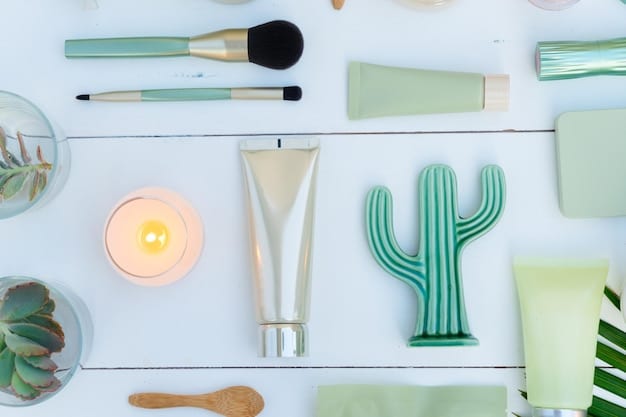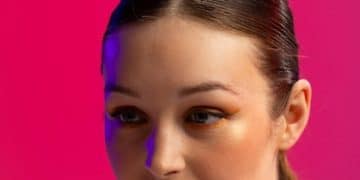Unlock Your Youthful Glow: The Power of Retinoids in Skincare

Unlocking the Secrets to a Youthful Glow: The Role of Retinoids in Your Skincare Routine involves leveraging the potent benefits of retinoids, a class of compounds derived from vitamin A, known for their ability to reduce wrinkles, stimulate collagen production, and improve skin texture, leading to a rejuvenated and radiant complexion.
Are you searching for the fountain of youth in a skincare bottle? Look no further than retinoids. Unlocking the Secrets to a Youthful Glow: The Role of Retinoids in Your Skincare Routine might be simpler than you think. Let’s explore how these vitamin A derivatives can transform your skin.
Understanding Retinoids: The Science Behind Youthful Skin
Retinoids are vitamin A derivatives that have become a cornerstone of modern skincare. They’re not just a trend; they’re backed by decades of scientific research proving their effectiveness. But what exactly are they, and how do they work their magic?
What are Retinoids?
Retinoids encompass a group of compounds derived from vitamin A. These include over-the-counter options like retinol and retinyl palmitate, as well as prescription-strength options such as tretinoin (Retin-A) and tazarotene. The key difference lies in their potency and how quickly they convert into retinoic acid, the active ingredient that interacts with your skin cells.
Retinoids work by:
- Increasing cell turnover: They help shed dead skin cells, revealing fresher, brighter skin underneath.
- Stimulating collagen production: Collagen is essential for maintaining skin elasticity and reducing the appearance of wrinkles.
- Reducing hyperpigmentation: Retinoids can help fade dark spots and even out skin tone.
The Benefits of Retinoids for a Youthful Glow
The benefits of incorporating retinoids into your skincare routine are numerous. From reducing wrinkles to improving skin texture, retinoids offer a comprehensive approach to achieving a youthful complexion.
- Reduce wrinkles and fine lines: By stimulating collagen production, retinoids help to plump the skin and minimize the appearance of wrinkles.
- Improve skin texture: They smooth out rough patches and uneven skin tone, resulting in a more refined complexion.
- Minimize pores: Retinoids can help to unclog pores and reduce their visibility.
- Treat acne: They can prevent breakouts by keeping pores clear and reducing inflammation.
Retinoids are powerful ingredients that can significantly improve the health and appearance of your skin. By understanding how they work and their many benefits, you can make an informed decision about whether to incorporate them into your skincare routine. Remember to start slow and consult with a dermatologist to determine the best retinoid for your skin type and concerns.
Choosing the Right Retinoid: Over-the-Counter vs. Prescription
Navigating the world of retinoids can be overwhelming, especially with so many options available. Deciding between over-the-counter (OTC) and prescription retinoids is a crucial first step. Each type has its pros and cons, and the best choice depends on your individual skin concerns and sensitivity.
Over-the-Counter Retinoids: A Gentle Introduction
OTC retinoids, like retinol and retinyl palmitate, are generally less potent than prescription options. They need to be converted into retinoic acid by the skin, a process that can take time. This makes them a good starting point for those with sensitive skin or those who are new to retinoids.
Benefits of OTC retinoids:
- Accessibility: They’re readily available at drugstores and online.
- Lower risk of irritation: Their milder potency reduces the likelihood of dryness, redness, and peeling.
- Gradual results: While results may take longer to appear, they can still be significant over time.
Prescription Retinoids: Powerful Solutions for Specific Concerns
Prescription retinoids, such as tretinoin (Retin-A) and tazarotene, are more potent and work directly as retinoic acid. This means they deliver faster and more dramatic results, but they also come with a higher risk of side effects.
Benefits of prescription retinoids:
- Faster, more visible results: They can significantly improve wrinkles, acne, and hyperpigmentation in a shorter time frame.
- Higher concentration of active ingredient: This allows for more effective treatment of stubborn skin concerns.
- Targeted treatment: Dermatologists can prescribe specific retinoids tailored to your individual needs.

Choosing between OTC and prescription retinoids depends on your skin type, concerns, and tolerance. If you have sensitive skin or are new to retinoids, start with an OTC option. If you have more severe skin concerns or are looking for faster results, consult with a dermatologist about prescription retinoids. Regardless of which you choose, remember to introduce retinoids slowly into your routine and always use sunscreen.
How to Incorporate Retinoids Into Your Skincare Routine: A Step-by-Step Guide
Introducing retinoids into your skincare routine requires a strategic approach to minimize irritation and maximize benefits. A slow and steady approach is key, along with proper application techniques and complementary skincare products.
Start Slow and Low
Begin by using a low concentration retinoid (like retinol) once or twice a week. Gradually increase the frequency as your skin becomes more tolerant. This “low and slow” approach helps to avoid the common side effects like redness, peeling, and dryness.
Tips for starting slow:
- Apply at night: Retinoids can make your skin more sensitive to the sun, so it’s best to use them in the evening.
- Use a pea-sized amount: This is enough to cover your entire face.
- Apply on dry skin: Applying retinoids to damp skin can increase absorption and irritation. Wait 20-30 minutes after cleansing before applying.
The Retinoid Sandwich Method
The “retinoid sandwich” method involves applying a moisturizer before and after your retinoid. This helps to buffer the retinoid and reduce irritation, while still allowing it to penetrate the skin.
Steps for the retinoid sandwich method:
- Cleanse your face: Use a gentle cleanser to remove dirt and makeup.
- Apply a moisturizer: Use a non-comedogenic moisturizer to hydrate your skin.
- Apply your retinoid: Use a pea-sized amount and spread it evenly over your face.
- Apply another layer of moisturizer: This helps to lock in moisture and further reduce irritation.
By starting slow and using the retinoid sandwich method, you can gradually introduce retinoids into your routine without overwhelming your skin. Remember to listen to your skin and adjust the frequency and concentration of your retinoid as needed.
Managing Retinoid Side Effects: Tips and Tricks
While retinoids are incredibly effective, they can come with some temporary side effects. Dryness, redness, peeling, and increased sensitivity to the sun are common, especially when first starting out. However, with the right strategies, these side effects can be managed, allowing you to reap the benefits of retinoids without significant discomfort.
Hydration is Key
One of the most important ways to combat retinoid side effects is to keep your skin well-hydrated. Use a rich, non-comedogenic moisturizer both morning and night. Look for ingredients like hyaluronic acid, ceramides, and glycerin, which help to draw moisture into the skin and strengthen the skin barrier.
Additional hydration tips:
- Use a humidifier: A humidifier can help to increase the moisture level in your home, especially during dry winter months.
- Avoid hot showers: Hot water can strip your skin of its natural oils, leading to dryness. Opt for lukewarm water instead.
- Drink plenty of water: Staying hydrated from the inside out is essential for healthy skin.
Sun Protection is Non-Negotiable
Retinoids can make your skin more sensitive to the sun, so wearing sunscreen every day is crucial. Choose a broad-spectrum sunscreen with an SPF of 30 or higher. Apply it liberally and reapply every two hours, especially if you’re spending time outdoors.
Sunscreen tips:
- Use a physical sunscreen: Physical sunscreens (containing zinc oxide or titanium dioxide) are generally less irritating than chemical sunscreens.
- Apply sunscreen even on cloudy days: UV rays can penetrate clouds, so it’s important to protect your skin every day.

Managing the side effects of retinoids requires a proactive approach. By prioritizing hydration, sun protection, and gentle skincare, you can minimize discomfort and allow your skin to adapt to the retinoid, ultimately achieving a youthful and radiant complexion.
Retinoids and Different Skin Types: Tailoring Your Approach
Not all skin is created equal, and different skin types may react differently to retinoids. Understanding how retinoids interact with various skin types is crucial for tailoring your approach and minimizing potential irritation.
Retinoids for Dry Skin
Dry skin is more prone to irritation from retinoids. If you have dry skin, focus on hydration and barrier repair. Choose a retinoid with moisturizing ingredients and use the “retinoid sandwich” method.
- Use a gentle cleanser: Avoid harsh soaps that can strip your skin of its natural oils.
- Apply a hydrating serum: Look for serums containing hyaluronic acid or ceramides.
- Use a rich moisturizer: Choose a thick, creamy moisturizer to lock in hydration.
Retinoids for Oily Skin
Oily skin may tolerate retinoids better than dry skin, but it’s still important to start slow and monitor for any signs of irritation. Retinoids can help to regulate oil production and prevent breakouts.
- Choose a lightweight moisturizer: Opt for a non-comedogenic moisturizer that won’t clog pores.
- Use a toner: A toner can help to remove excess oil and prepare your skin for the retinoid.
- Consider a prescription retinoid: If you have acne-prone skin, a prescription retinoid like tretinoin may be more effective.
By understanding how retinoids interact with different skin types, you can tailor your approach to minimize irritation and maximize benefits. Whether you have dry, oily, or sensitive skin, retinoids can be a valuable addition to your skincare routine with proper care and attention.
Beyond Retinoids: Complementary Skincare for a Youthful Glow
While retinoids are a powerhouse ingredient, they’re not the only key to a youthful complexion. A well-rounded skincare routine that includes complementary ingredients can enhance the effects of retinoids and address other aspects of skin aging.
Antioxidants: Protecting Your Skin from Damage
Antioxidants help to protect your skin from free radical damage, which can contribute to wrinkles, dark spots, and other signs of aging. Incorporate antioxidants like vitamin C, vitamin E, and green tea extract into your routine.
Benefits of antioxidants:
- Protect against sun damage: Antioxidants can help to neutralize free radicals caused by sun exposure.
- Brighten skin: Vitamin C can help to fade dark spots and even out skin tone.
- Reduce inflammation: Antioxidants can help to soothe irritated skin.
Peptides: Building Blocks for Collagen
Peptides are amino acids that help to stimulate collagen production, improving skin elasticity and reducing wrinkles. Look for skincare products containing peptides like Matrixyl and copper peptides.
Benefits of peptides:
- Improve skin firmness: Peptides can help to strengthen the skin’s support structure.
- Reduce wrinkles: They can help to plump the skin and minimize the appearance of wrinkles.
- Hydrate skin: Some peptides have hydrating properties.
By incorporating complementary skincare ingredients like antioxidants and peptides, you can create a comprehensive skincare routine that enhances the effects of retinoids and promotes a youthful, radiant complexion. Remember to choose products that are suitable for your skin type and concerns, and always use sunscreen to protect your skin from sun damage.
| Key Point | Brief Description |
|---|---|
| ✨ Retinoid Benefits | Reduces wrinkles, stimulates collagen, improves skin texture. |
| 🧴 OTC vs. Prescription | OTC is milder; prescription is stronger, for faster results. |
| ☀️ Sun Protection | Crucial due to increased skin sensitivity. Use SPF 30+. |
| 💧 Hydration | Essential to combat dryness; use moisturizers with hyaluronic acid and ceramides. |
Frequently Asked Questions About Retinoids
▼
Retinoids primarily reduce wrinkles, boost collagen production, improve skin texture and tone, and can effectively treat acne by unclogging pores and reducing inflammation.
▼
Start with applying retinoids 1-2 times a week at night. Gradually increase frequency as your skin tolerates it, monitoring for any irritation or dryness.
▼
Yes, but proceed with caution. Start with a low-concentration OTC retinoid and use the “retinoid sandwich” method to minimize irritation. Consult a dermatologist if needed.
▼
Retinoids increase your skin’s sensitivity to the sun, making it more prone to sunburn and damage. Daily sunscreen use is essential to protect your skin.
▼
Ingredients like hyaluronic acid, ceramides, peptides, and antioxidants such as vitamin C enhance retinoid benefits and help maintain overall skin health and hydration.
Conclusion
Unlocking the Secrets to a Youthful Glow: The Role of Retinoids in Your Skincare Routine is multifaceted, yet attainable by incorporating retinoids thoughtfully. Integrating these potent vitamin A derivatives, coupled with strategic skincare choices, promises a visibly rejuvenated and healthy complexion. Approach their use wisely to reveal your most radiant skin.





